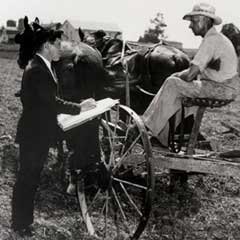Statewide Wisconsin Census records that exist are 1820, 1830 (as Michigan Territory), 1840 (as Wisconsin Territory), 1850, 1860, 1870, 1880, 1890 (fragment, see below), 1900, 1910, 1920, 1930 and 1940.
There are Industry and Agriculture Schedules 1850, 1860, 1870 and 1880. The Mortality Schedules for the years 1850, 1860, 1870 and 1880. The Union Veterans Schedules exist for 1890.
The Wisconsin Historical Society holds copies of federal census records for the state of Wisconsin, as well as every other U.S. state. Original copies of the Wisconsin federal censuses for 1850, 1860, and 1870 can also be found there.
The 1850, 1860, and 1870 state copies of the census also have an every-name index available at the Wisconsin Historical Society. All of the federal census records for Wisconsin can also be viewed online, along with their indexes.
However, there may be some variations between the federal and state copies of the census records for certain years. Indexes of mortality schedules can be obtained through inter-library loan programs. However, there is not index available for the 1880 mortality schedules.
The Works Projects Administration (WPA) indexed the Wisconsin census records from 1820 to 1870. Those records list every person in the state at the time that those censuses were taken.

On April 20, 1836, Wisconsin’s territorial government was created. At that time, sheriffs were to take enumerations of the residents of each county and send the results to the governor prior to the election taking place.
Pre-printed forms were not available for that census. Instead, each sheriff wrote down the names of the heads of families by hand, along with the number of family members, their sexes, and their age ranges (split into 4 categories). As a result, each sheriff’s records varied. For example, the Crawford County sheriff listed sections for “slaves and coloured,” as well as aliens.
He also placed those who were dumb, blind, or deaf in their own section. In addition to that, certain families seemed to be unusually large in the census records. For instance, the Daniel Whitney family included those who worked for Mr. Whitney in his lumber camps and sawmills.
Wisconsin State and Territorial Census
- Years taken 1836, 1838, 1842, 1846, 1847, 1855, 1865, 1875, 1885, 1895, 1905
- Local census enumerations were taken between 1848 and 1959, ordered for qualification as a municipality by the state. Copies were required to be kept by the county register of deeds and the village or city clerk. Some of these censuses have been found in circuit court files.
The Wisconsin State Archives, which is at the Wisconsin Historical Society, holds most of the original state census records. Copies can be purchased on microfilm or viewed through inter-library loan programs. Some of those records include:
- 1836 (AISI index): Names only head of household, plus numeric listing of household; published in Wisconsin Historical Collections 13 (1895): 247-70.
- 1838 (AISI index): Includes name of master, mistress, steward, overseer, or other principal person; name of head of family, and numeric listing of household; only records for certain counties are available.
- 1842 (AISI index): Similar to 1838.
- 1846: Includes name of head of family; numeric listing of household by sex and color; some counties missing.
- 1847: Same as 1846; some counties missing.
- 1855 (AISI index): Similar to 1847, plus number of deaf and dumb, blind, or insane; includes number of individuals in each household of foreign birth; Kewaunee County records are missing.
- 1865: Listing same as 1855; most schedules appear to have been destroy; only a few schedules survived (Crawford, Dane, Dunn, Green, Jackson, Kewaunee, Ozaukee, Racine and Sheboygan). A printed and bound index by Barry Noonan is available at the Wisconsin Historical Society.
- 1875: Listing similar to 1855.
- 1885: Listing similar to 1855, plus some additional information on number of foreign-born persons and a special enumeration of “Soldiers and Sailors of the Late War.”
- 1895: Same as 1885, including veterans’ schedules.
- 1905: Includes name of each individual, relationship to head of household, color or race, sex, age at last birthday, marital status, place of birth, place of birth of parents, occupation, number of months employed, whether home or farm is owned or rented; also includes veterans’ enumeration; indexed, by county, on microfilm.
From 1848 to 1959, local censuses were taken in order for certain areas to qualify to be recognized as municipalities. The county register of deeds or the clerk of the city or village kept copies of those records. Some of those records have also made their way into the files of the circuit court.
In cases where census records are missing, city directories may be able to fill in missing information.
Directories for Milwaukee dating back to 1846 and directories for other Wisconsin cities dating back to the 1850s can be found at the Wisconsin Historical Society.
Some directories may also be found at Area Research Centers, historical societies, and libraries across Wisconsin.
Searchable Wisconsin Census Databases
- Wisconsin State Censuses, 1895 and 1905
- Wisconsin Census, 1820-90
- Wisconsin, State Census, 1855
- Wisconsin, State Census, 1875
- Wisconsin, State Census, 1885
- Wisconsin, State Census, 1895
- Wisconsin State Census, 1905
- 1860 Federal Slave Schedule
Further Reading
- Genealogical Research: An Introduction to the Resources of the State Historical Society of Wisconsin (Madison, Wis.: State Historical Society of Wisconsin, 1986).
- Michigan Censuses, 1710–1830, Under the French, British and Americans (Detroit: Detroit Society for Genealogical Research, 1982).
- Michigan Voyageurs, From the Notary Book of Samuel Abbott, Mackinac Island, 1807–1817 (Detroit: Detroit Society for Genealogical Research, 1982).
